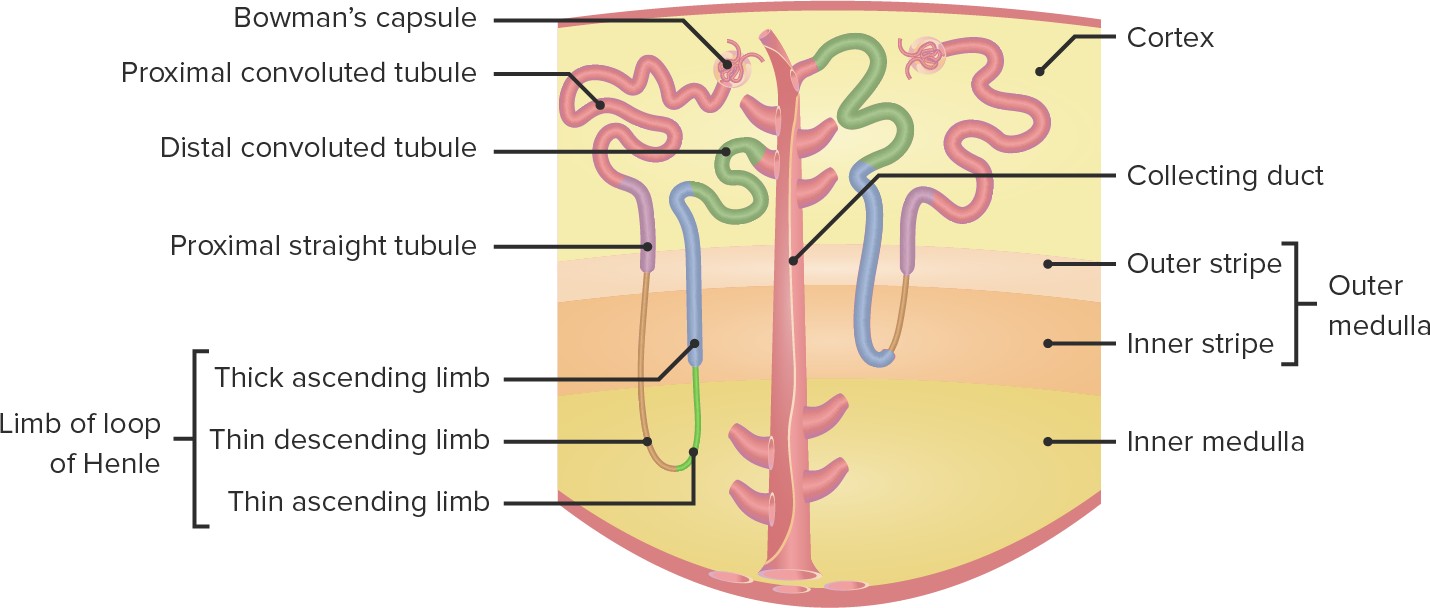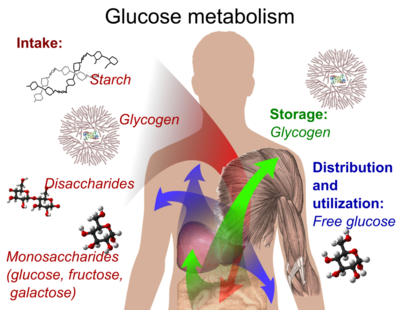Which of the following organelles is responsible for modifying, sorting and packaging proteins and lipids?
A. Golgi apparatus
B. Mitochondria
C. Ribosomes
D. Endoplasmic reticulum
The correct answer is choice A. Golgi apparatus.
The Golgi apparatus is a membrane-bound organelle that is responsible for transporting, modifying, and packaging proteins and lipids into vesicles for delivery to targeted destinations.
Choice B is incorrect because mitochondria are responsible for energy production.
Choice C is incorrect because ribosomes are responsible for protein production.
Choice D is incorrect because the endoplasmic reticulum is responsible for lipid production and protein production, but not for modifying, sorting and packaging proteins and lipids.
Therefore, the Correct Answer is A.
More Questions on TEAS 7 Science
-
Q #1: Which of the following structures in the nephron is responsible for reabsorbing ions, water and nutrients?
A. Distal tubule
B. Proximal tubule
C. Glomerulus
D. Loop of Henle
Answer Explanation
Proximal tubule
The proximal tubule is responsible for reabsorbing all the nutrients and most of the water.

Choice A is incorrect because the distal tubule is not primarily responsible for reabsorbing ions, water and nutrients.
Choice C is incorrect because the glomerulus is responsible for filtering fluid and solutes out of the blood to form a glomerular filtrate.
Choice D is incorrect because the Loop of Henle is not primarily responsible for reabsorbing ions, water and nutrients.
-
Q #2: What is a control group used for in scientific studies?
A. To establish causality by isolating the effect of an independent variable.
B. To establish the effect of a dependent variable on an independent variable.
C. To control the impact of extraneous variables on the dependent variable.
D. To control the impact of extraneous variables on the independent variable.
Answer Explanation
A control group is used in scientific studies to establish causality by isolating the effect of an independent variable.
The control group serves as a baseline or comparison group that does not receive the treatment or intervention being tested.

By comparing the results of the control group to the experimental group, researchers can determine if any observed changes are due to the independent variable or if they are due to chance or other factors.
Choice B is incorrect because a control group is not used to establish the effect of a dependent variable on an independent variable.
Choice C is incorrect because while a control group can help control for the impact of extraneous variables on the dependent variable, its primary purpose is to isolate the effect of the independent variable.
Choice D is incorrect because a control group is not used to control for the impact of extraneous variables on the independent variable.
-
Q #3: Which of the following is an example of a storage form of glucose in the human body?
A. Starch
B. Glycogen
C. Fructose
D. Cellulose
Answer Explanation
Glycogen is the storage form of glucose in the human body.
It is a polysaccharide that is stored primarily in the liver and muscle tissue and can be broken down into glucose when the body needs energy.

Choice A is incorrect because starch is a storage form of glucose in plants, not in the human body.
Choice C is incorrect because fructose is a simple sugar, not a storage form of glucose.
Choice D is incorrect because cellulose is a structural carbohydrate found in plant cell walls, not a storage form of glucose in the human body.
-
Q #4: Which type of lymphocyte is capable of killing tumor cells and infected cells without prior sensitization?.
A. Helper T cells.
B. B cells.
C. Natural killer cells.
D. Cytotoxic T cells .
Answer Explanation
Natural killer cells.
Natural killer (NK) cells are large granular lymphocytes that are capable of destroying cells infected by viruses or bacteria and susceptible tumor cells without prior sensitization and restriction by MHC antigens.
Helper T cells (choice A) are a type of white blood cell that helps other immune cells respond to infections but do not directly kill infected or tumor cells.
B cells (choice B) are a type of white blood cell that produces antibodies to fight infections but do not directly kill infected or tumor cells.
Cytotoxic T cells (choice D) are a type of white blood cell that can kill infected or tumor cells but require prior sensitization to do so.
-
Q #5: A nurse is caring for a patient who has suffered a traumatic brain injury after falling from a height. The nurse knows that the severity of the injury depends on the speed at which the patient hit the ground. Which of the following factors affects the terminal velocity of a falling object?
A. The shape and surface area of the object.
B. The mass and volume of the object.
C. The acceleration and momentum of the object.
D. The height and distance of the fall.
Answer Explanation
The correct answer is choice A.
The shape and surface area of the object.
The terminal velocity of an object falling through a fluid is affected by several factors, including its mass and shape.

Objects with large surface areas will often experience a large amount of air resistance when they move.
Choice B is incorrect because the volume of the object does not affect its terminal velocity.
Choice C is incorrect because the acceleration and momentum of the object do not affect its terminal velocity.
Choice D is incorrect because the height and distance of the fall do not affect the terminal velocity of a falling object.
-
Q #6: A patient with chronic kidney disease is at risk for developing which of the following electrolyte imbalances?
A. Decrease in the concentration of calcium in the glomerulus.
B. Increase in the concentration of potassium in the blood.
C. Decrease in the concentration of sodium in the blood.
D. Increase in the concentration of magnesium in the blood.
Answer Explanation
The correct answer is choice B.
A patient with chronic kidney disease is at risk for developing an increase in the concentration of potassium in the blood.
The kidneys play a pivotal role in the regulation of electrolyte balance.
With progressive loss of kidney function, derangements in electrolytes inevitably occur and contribute to poor patient outcomes123.
Choice A is incorrect because calcium concentration is not regulated in the glomerulus.
Choice C is incorrect because chronic kidney disease can result in either an increase or decrease in sodium concentration in the blood.
Choice D is incorrect because chronic kidney disease does not necessarily result in an increase in magnesium concentration in the blood.
-
Q #7: Which of the following is a mechanism that the body uses to regulate blood pH levels?
A. Increased respiration rate to remove excess CO2.
B. Decreased respiration rate to retain CO2.
C. Increased water intake to dilute the blood.
D. Decreased water intake to concentrate the blood.
Answer Explanation
The correct answer is choice A.
Increased respiration rate to remove excess CO2.
The body regulates blood pH through several mechanisms, including chemical buffers, the respiratory system, and the urinary system.
The respiratory system can adjust blood pH by changing the rate of respiration to remove or retain CO2.
When there is excess acid in the blood, the respiratory rate increases to remove more CO2, which helps to raise blood pH.
Choice B is incorrect because decreasing the respiration rate would retain CO2, which would lower blood pH.
Choice C is incorrect because increased water intake would not directly affect blood pH levels.
Choice D is incorrect because decreased water intake would not directly affect blood pH levels.
-
Q #8: What is the relationship between viruses and their host cells during replication?
A. Viruses use the host’s replication processes to produce progeny virus particles.
B. Viruses divide inside the host cell to produce progeny virus particles.
C. Viruses have their own replication processes and do not need the host cell.
D. Viruses infect the host cell and destroy it completely.
Answer Explanation
Viruses use the host’s replication processes to produce progeny virus particles.
Viruses are obligate intracellular parasites, meaning that they require a host cell to replicate.
They hijack the host cell’s machinery to produce new virus particles.

Choice B is incorrect because viruses do not divide inside the host cell.
Instead, they use the host cell’s machinery to produce new virus particles.
Choice C is incorrect because viruses do not have their own replication processes and rely on the host cell for replication.
Choice D is incorrect because while some viruses may destroy the host cell during replication, this is not always the case and is not the primary relationship between viruses and their host cells during replication.
-
Q #9: Why is water sometimes called the "universal solvent"?.
A. Because water dissolves all solutes equally well.
B. Because water is a nonpolar solvent.
C. Because water is good at dissolving ions and polar molecules.
D. Because water is poor at dissolving nonpolar molecules.
Answer Explanation
Water is sometimes called the “universal solvent” because it dissolves more substances than any other liquid.
This is due to its polarity and ability to form hydrogen bonds, which allows it to dissolve ions and polar molecules.
Choice A) Because water dissolves all solutes equally well is incorrect because water does not dissolve all solutes equally well.
Choice B) Because water is a nonpolar solvent is incorrect because water is a polar solvent.
Choice D) Because water is poor at dissolving nonpolar molecules is incorrect because it does not explain why water is called the “universal solvent”.
-
Q #10: Which of the following organelles is responsible for modifying, sorting and packaging proteins and lipids?
A. Golgi apparatus
B. Mitochondria
C. Ribosomes
D. Endoplasmic reticulum
Answer Explanation
The correct answer is choice A. Golgi apparatus.
The Golgi apparatus is a membrane-bound organelle that is responsible for transporting, modifying, and packaging proteins and lipids into vesicles for delivery to targeted destinations.
Choice B is incorrect because mitochondria are responsible for energy production.
Choice C is incorrect because ribosomes are responsible for protein production.
Choice D is incorrect because the endoplasmic reticulum is responsible for lipid production and protein production, but not for modifying, sorting and packaging proteins and lipids.
Free Access on TEAS 7 Exams and Study Notes
- Access to all TEAS 7 Exams
- Performance Tracking and Analysis
- Well Documented and Explained Questions and Answers
- 2000+ Questions and Correct Answers: Answers Well Explained
- Libary of Detailed StudyNotes
- Topical Questions and Answers on Examinable topics
TEAS 7 Exams (Q&A)
TEAS 7 Study Notes
TEAS 7 Topical Tests

TEAS 7 Study Guides
Quick Links
Refer a Friend
Refer a friend and claim free unlimited access

© 2024 ExamGates Made with by ExamGates
